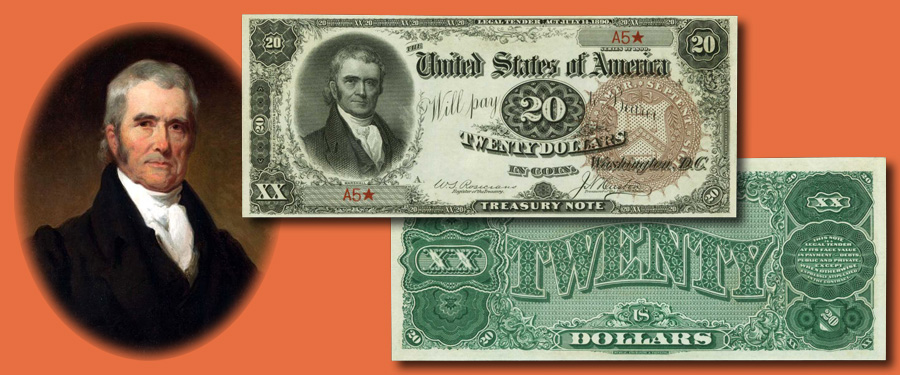
Among the many great lots being offered in our Official Auction of the ANA World’s Fair of Money in August is the finest known Fr. 372 1890 $20 Treasury Note. This ornate back note with large brown Treasury Seal bears ultra low serial number A5 and is graded Gem New 66 by PCGS. Featured on the note is the portrait of Supreme Court Justice John Marshall.
Marshall was born in what is now Fauquier County, Virginia on September 24, 1755. His father, Thomas Marshall, was employed by Lord Fairfax who owned much of the Shenandoah and Potomac valleys. The family’s relative affluence allowed young John to gain a substantial education at a time when no schools were available in the area.
During the Revolutionary War Marshall served in the Continental Army where he befriended George Washington and endured the brutal winters at Valley Forge. After his time in the army he attended the College of William and Mary where he studied law. He was admitted to the Bar in 1780.
Marshall successfully practiced law in Virginia from 1780 into the 1790s. In 1795 he declined Washington’s offer to become Attorney General of the United States and in 1796 declined to serve as minister to France. In 1797 Marshall accepted an appointment from John Adams to a three-member commission to represent the United States in France. However, once the diplomats arrived they discovered the French would not negotiate with the Americans unless the United States paid large bribes to the French. In what became known as the XYZ Affair, Marshall and the other American diplomats left France in protest and returned to the United States. Marshall came home to positive public opinion for his handling of the situation in France.
Marshall was named Secretary of State under Adams and took office in June of 1800. In that role Marshall guided the negotiation of the Convention of 1800, which brought an era of peace between the young United States and France. In a surprise move in 1801 with Adams as a lame duck president, Marshall was nominated to replace the ailing Oliver Ellsworth as Chief Justice of the Supreme Court. He was confirmed by the Senate on January 27, though he continued to serve as Secretary of State until the expiration of Adams’ term on March 4.
As chief justice, Marshall augmented the role of the judiciary branch by tossing out laws that violated the Constitution and establishing the supremacy of federal law over state law. Marshall was a staunch Federalist who supported building a stronger federal government, as opposed to the Jeffersonian Republicans who supported stronger state governments. During his time as chief justice, Marshall wrote most of the court’s opinions and influenced the other justices, molding a court that rarely disagreed.
Perhaps the greatest legacy of Marshall’s tenure came in 1803 with the Marbury v. Madison decision. In this case the court, led by Marshall, ruled an act of Congress unconstitutional. The decision reinforced the doctrine of judicial review and essentially cemented the court as an equal branch along with the executive and legislative branches.
Between 1804 and 1807, Marshall, who was both a friend and admirer of George Washington, wrote a five-volume biography of the first president. He also prepared and published several condensed versions of the biography in subsequent years.
Marshall died July 6, 1835, in Philadelphia at the age of 79. At the time of his death he still held his seat as chief justice, having served over 34 years in that position. He still remains the longest serving chief justice of the United States Supreme Court and is the fourth longest serving justice of all time.





